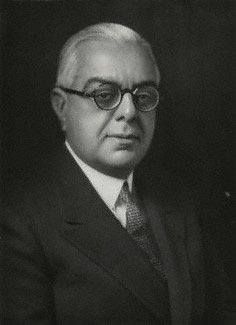“The Imam’s true face is to be perceived with the eyes of the heart.
He has thousands of physical habitations, but his true home is traceless;
He has had a thousand names, but all of them refer to one reality.”
33rd Ismaili Imam ‘Abd al-Salam, 15th Century
1. SUCCESSION
Sir Sultan Muhammad Shah, Aga Khan III. Photo Copyright National Portrait Gallery, London
by Elliott & Fry photograph.By Mawlana Sultan Mahomed Shah,
His Highness the Aga Khan III
“Ever since the time of my first ancestor Ali, the first Imam, that is to say over a period of thirteen hundred years it has always been the tradition of our family that each Imam chooses his successor at his absolute and unfettered discretion from amongst any of his descendants whether they be sons or remoter male issue.
“In view of the fundamentally altered conditions in the world in very recent years due to the great changes which have taken place including the discoveries of atomic science I am convinced that it is in the best interests of the Shia Moslem Ismailian Community that I should be succeeded by a young man who has been brought up and developed during recent years and in the midst of the new age and who brings a new outlook on life to his office as Imam.
“I appoint my grandson Karim, the son of my son Aly Salomone Khan to succeed to the title of Aga Khan and to be the Imam and Pir of all my Shia Ismailian followers.”
2. THE MOMENT OF SUCCESSION, THE HEREDITARY INSTITUTION AND THE NOOR OF IMAMAT
A portrait of Prince Karim Aga Khan IV during his enthronement in Geneva, Switzerland after his grandfather, His Highness the Aga Khan III, passed away on July 11, 1957. Photo by Philippe Le Tellier/Paris Match via Getty Images.
By Mawlana Shah Karim al-Hussaini Hazar Imam, His Highness the Aga Khan
“The [installation] ceremony is a public installation of the Imam. The Ismailis pay homage to the Imam and that is when you are recognised by the world at large as the Imam.
“Officially as soon as one Imam passes away, his successor takes on from the very minute the Imam has passed away .” [1]
~~~
“The Ismaili Imamat is a supra-national entity, representing the succession of Imams since the time of the Prophet….today the Ismailis are the only Shia community who, throughout history, have been led by a living, hereditary Imam in direct descent from the Prophet.
“…As the 49th Imam, I have for the past 50 years, looked after two inseparable responsibilities: overseeing the spiritual wellbeing of Ismailis, as well, at the same time, as focusing on improving their quality of life and that of the people with whom they live.” [2]
~~~
“For hundreds of years, my spiritual children have been guided by the Rope of Imamat; you have looked to the Imam of the Age for advice and help in all matters and through your Imam’s immense love and affection for his spiritual children, his Noor has indicated to you where and in which direction you must turn so as to obtain spiritual and worldly satisfaction. [3]
3. TWO 15TH CENTURY ISMAILIS IMAMS ON ZAHERI AND BATINI DIDAR, AND IMAM’S ESSENCE
(a) Imam Mustansir bi’llah
Pandiyat-i- Jawanmardi or Counsels of Chivalry is a compilation of the guidance of the 32nd Ismaili Imam, Mustansir bi’llah, who lived in the 15th century. This book contains exhortations to the faithful on the necessity of recognising and obeying the current Imam and on how to live a truly ethical life. The circumstances that led to the compilation of the work are intriguing, and are alluded to in many of the manuscripts copies as follows:
When Pir Taj al-Din passed away, a number of people from the Sindhi Ismaili Community went to the Imam. Upon arrival they pleaded: “Our Pir Taj al-Din has passed away. Now we are in need of a Pir.” The Imam then had the Counsels of Chivalry compiled and gave it to them saying: “This is your Pir. Act according to its dictates.”
In one of the chapters, the Imam enumerates the importance of both the Zaheri and Batini aspects of the Imam’s Didar. He recognizes and acknowledges the sacrificing spirit of the Jamat, in serving him and in observing religious duties.
He says:
“They (the Jamat, the community) have given up their property, and even their lives. All of them have faithfully submitted their religious dues. Others have travelled long distances through arduous conditions by land and sea, braving storms and incurring great expense.
“Some attend religious assemblies to increase their knowledge while others, without any worldly motive, perform acts of charity to benefit the poor.
“Some have acted with noble actions in the cause of faith, including special devotions, worship and especially remembrance (zikr), continually invoking the Lord throughout the night, never neglecting God for even a moment, and worshipping him out of passionate devotion.
“All believers are urged to come into the presence of the Imam and to see him with their own eyes.
“Thus, the esoteric (batini) vision, realized through pious works and the constant remembrance of God during the nightly vigil, as well as the exoteric (zaheri) vision, achieved by travelling to the Imam’s residence and beholding the gateway of God’s mercy, become the ultimate purpose of human life.
“Piety should be for the purpose of recognizing and beholding God, which is achieved through the recognition and vision of the Imam of one’s time.”
(b) Imam ‘Abd al-Salam
There is an ode of the 33rd Ismaili Imam ‘Abd al-Salam in which he says that the talisman (anything that has magical powers) that can open the treasure trove of spiritual meaning of the Holy Qur’an is the Imam. This ode is lucidly explained by Dr. Shafique Virani in his path breaking book, “The Ismailis in the Middle Ages.”
In the ode the Imam observes that the true essence of the Imam cannot be recognized with earthly, fleshly eyes, for these can only see his physical form, perishing like all else with the passage of time. His true face is to be perceived with the eyes of the heart. He has thousands of physical habitations, but his true home is traceless; he has had a thousand names, but all of them refer to one reality.
The Imam continues by saying that today he is known as ‘Abd al-Salam, but tomorrow the physical body will be gone and the name will change, yet the essence will remain in the next Imam of the lineage. Those who look at the Imam as they squint will consider him like any other human being, but as soon as the eyes of the heart perceive correctly, his true status is discovered. In form the Imams change, but in meaning and substance they are changeless. Human language cannot attain to the majesty of the Imams.
The Imam is the most precious ingredient in the supreme elixir (miraculous substance) of eternal life-red sulfur. He is not simply a pearl, but the ocean that gives birth to pearls. The existence of the Imam, who leads humankind to a recognition of God, is the very pinnacle of creation.
Date posted: July 10, 2015.
_______________
Previous posts in this special series:
- Special Series: Ismaili Expressions on the Imamat — (II) The Beatific Vision of the Imam of the Time
- Special Series: Ismaili Expressions on the Imamat and Imam of the Time — (I) The Preamble of the Constitution of the Shia Imami Ismaili Muslims
References:
[1] Click http://www.nanowisdoms.org
[3] Farman Mubarak Pakistan Visit 1964, published by the Ismailia Association for Pakistan. Quoted also in Ilm magazine, July 1975, Volume 1, Number 1, page 27, published by the Ismailia Association for the United Kingdom (known since 1986 as the Ismaili Tariqah and Religious Education Board or ITREB)
Note: Reading 3 compiled from The Ismailis in the Middle Ages, by Shafique N. Virani, and Pandiyat-i Jawanmardi, translated by Professor Vladimir Ivanow). Image courtesy of roseannapiter.com
To give a feedback, please click Leave a comment.




Reblogged this on Paderborner 'SJ' Blog.
Reblogged this on Zarina's Weblog and commented:
Please read my Comment on this Article.
Malik, how heart-warming as just last night on Lailtul Qadr night, I was asked to read out Pandiyat-i- Jawanmardi or Counsels of Chivalry in the Third Majalis. Thank you for your strengthening our unique Rope of Imamat we are blessed with as Shia Ismaili Muslims.